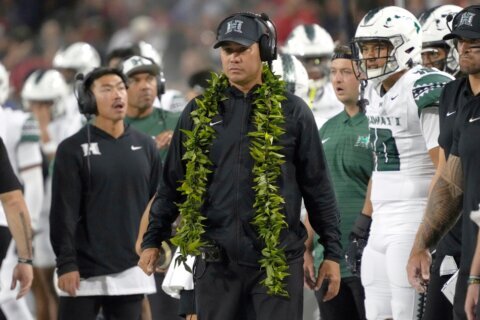It’s not easy being in the Big Ten East.
Maryland plays in arguably the second-most difficult division in FBS college football — behind the vaunted SEC West.
While Michigan State is a sneaky-good program (just ask Michigan) and Indiana can light up the scoreboard with anybody, the Terps won’t realistically be competitive in the East until they can at least slow down the East’s three biggest bullies: Since 2015, they’re 0-15 against Ohio State, Penn State and Michigan while allowing 40.4 points per game to the Wolverines, 46.4 points per game to the Nittany Lions, and — GULP! — a whopping 59.6 points per game to the Buckeyes.
And that doesn’t include other isolated games where they’ve coughed up 40 points to Purdue, 47 to Indiana and 54 to Nebraska.
Until the Terps get better on D, they’ll never be above a C student in a highly competitive class.
Last year’s defense finished 10th in the Big Ten stopping the run, 14th in containing the pass, 14th in yardage allowed and 13th in points surrendered.
What gives sophomore safety Nick Cross confidence that this year’s unit will be better?
“We had a lot of young guys play last year — we’re bigger, faster and stronger than we were last year,” Cross said. “We’re a tight-nit group and more athletic, and we’ll have a good time playing with each other.”
Cross made five starts as a true freshman and led the team in interceptions. He’s one of five sophomores in the starting lineup this year — a redshirt freshman and five juniors complete the opening week 11 — that had to grow up quickly in 2019 due to injuries as well as a new defensive scheme under first-year coordinator Jon Hoke.
“Coach Hoke emphasizes not giving up big plays and living to see the next down,” Cross said. “I believe that’s been the primary focus and emphasis this year.”
Of the 46 starts returning in 2020, 43 come in the “back eight”: 23 at linebacker (including returning leading tackler Ayinde Eley) and 20 in the secondary.
According to head coach Mike Locksley, those two units have made strides entering the fall.
“I saw an increase in team speed — our guys’ ability to get to the ball. Whether it’s the secondary, our second level players, our linebackers,” Locksley said. “As well as the fundamentals up front, I’ve been really happy with their ability to strike blocks and do the things up front we want to.”
About “up front”: Last year’s pass rush produced 21 sacks, the second fewest in the conference.
This year’s front three will get help from an active linebacking corps in a reshaped front seven.
“I’ve been really happy with some of the new nuances of our defensive system and scheme that (defensive coordinator) Jon Hoke and his staff have put together; that’s a major difference from maybe what we looked like last year,” Locksley said. “That I think will give us some advantages to be hopefully able to disrupt the quarterback. I think it will create some problems for people.”
The reformed front seven will be without last year’s top pass rusher, Keandre Jones (seven sacks).
“Keandre Jones wasn’t an imposing size guy, he was more of a twitchy explosive power guy. We feel good with the addition of (N.C. State transfer) Joe Boletepeli and Lawtez Rogers. Really happy having (sophomore) Ahmad McCullough back healthy to be able to add to the pass rush,” Locskley said. “[True freshman] Frankie Burgess jumps out as a guy who’s done a really good job and shows that he’ll have some pass rush ability.”
So far this fall, we’ve seen a bit of an offensive explosion in college football, from Alabama allowing 48 points and still beating Ole Miss, to Virginia Tech scoring 45 points and still losing at North Carolina.
Teaching defense in a pandemic world where contact is constant is a challenge.
“From a fundamental standpoint, we really put a lot of time even though we didn’t have pads on with understanding how to play the position,” Locksley said.
“How to defeat double teams up front. How to work the reach block. How to get off and shed blocks or block protection. You can do all of those things without pads on and so with the cards we were dealt within those time frames I feel like we’ve been able to get a lot of work done.”
The longest offseason ends this weekend for a Maryland team that has yet to produce a winning conference record since joining the Big Ten.
The Terps have started with the bang of an upset of No. 23 Texas (in successive years), followed by the whimper of a season-ending four game losing streak. They’ve followed up wins over Penn State and Michigan (on the road, no less) with a home loss to Rutgers.
As their seventh season in the conference commences, how quickly the defense gets in tune will be a factor in determining this season’s song.
“Obviously things they’ve got to work on: tackling. Because we haven’t done it since November 2019,” Locksley said. “Big emphasis especially whenever we have an opportunity to go live. To do a great job of making sure we get guys on the ground.”
Tackling and pursuit: two priorities to any successful defense in the Big Ten.
On Saturday, the Terps begin their pursuit of respectability by tackling another tough schedule.
- Maryland football preview, Part 1: Practicing in a pandemic world
- Maryland football preview, Part 2: Stopping the QB carousel
- Maryland football preview, Part 3: Boosting the offensive line
- Maryland football preview, Part 4: Terps’ D hoping for a better grade







